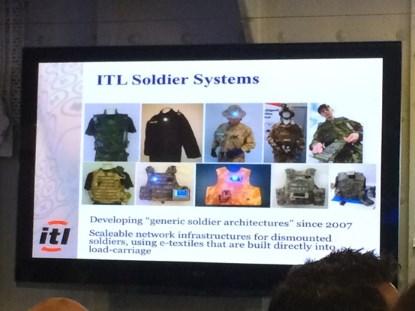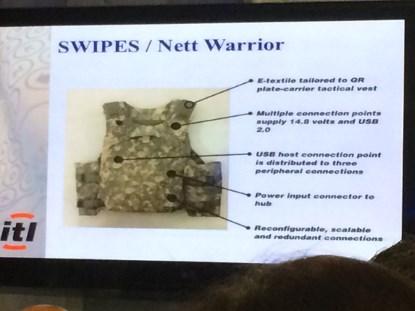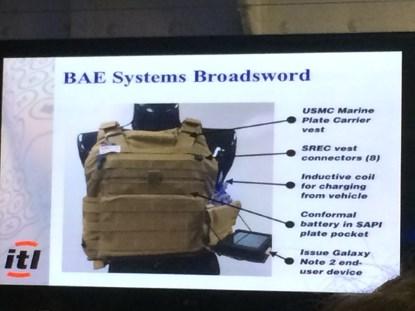



Feature Story
More feature stories by year:
2024
2023
2022
2021
2020
2019
2018
2017
2016
2015
2014
2013
2012
2011
2010
2009
2008
2007
2006
2005
2004
2003
2002
2001
2000
1999
1998
 Return to: 2015 Feature Stories
Return to: 2015 Feature Stories
CLIENT: IDTECHEX
July 27, 2015: EE Times
James Hayward, Technology Analyst, IDTechEx
When it comes to wearable technology for military applications, the needs of the users equate to life-or-death situations.
A recent conference aboard the HMS Belfast in London brought together senior military innovation personnel with acting servicemen and technical innovators in relevant fields. The topic: Wearable technology for the military.
Wearables for the military is one of today's hottest topics. You can learn more about that at the IDTechEx Wearable USA event Nov. 18-19, but below is a synopsis of the state of this advancing technology that focuses on the needs of the dismounted soldier in active service.
Military development programs revolve around improving the capabilities of the soldier. Technology platforms, whether they are wearable or not, and regardless of technical sophistication, will only ever be a part of the solution in this development process.
All of the military personnel at the HMS Belfast event agreed that too much of the development so far has been technology focused, without properly addressing the needs of the soldier. This is an expected problem for a small company looking to exploit new markets for their technology. At the other end of the spectrum, the likes of BAE Systems, Lockheed Martin, and others are involving military personnel earlier in the development process, but the challenge is significant because the stakes are at their highest.
The discussion also highlighted the significant issue of wearables being left behind. This is seen as a problem with consumer devices that is amplified when it comes to military platforms. WO1 Gary Simpson of the parachute regiment repeated a need to enhance the "situational awareness" for soldiers on the ground. However, with a 57 kg (125.4 lbs.) of weight to carry during operations, anything which is considered non-essential to an operation will simply be "left under the bed."
James Gerard from BAE Systems spoke of recent steps they have taken to get away from this approach; e.g., the development of warships. For more than a century, the approach has been almost entirely additive -- whether it be a bigger gun, better radar reflectors, torpedo resistant hull, and so on. Illustrating the concerted effort to move away from this, he described the Type 45 Destroyer, which involved a redesign with integration and functional optimization at its heart.
For the dismounted soldier, the solution needs focus on two key areas:
Adaptability: This describes a modular approach to the system, where different components can be selected depending on the mission or even personal preference. This requires connector standards and design integration between previously separate areas of equipment development.
Practicality: The device(s) should be based around the soldiers' needs. An average platoon carries 16 different kinds of batteries, with a single soldier requiring five or six different types. The lack of integration also extends to data connectors, wireless protocols, and equipment examples. This presents a logistical challenge to the majority of national military organizations, and needs to be understood by developers if they are to contribute positively to continued platform development.
When it comes to technology integration, the military has a mixed track record. At one end, huge investments are driving significant advances in weaponry, communications, armor, vehicles -- right through to exoskeletons and battlefield medicine. The same is true of wearable technology, but the additional human factors around soldier preference and weight severely limit the functionalities that can be employed.
So what is in place? Hand-held GPS, optical sights for weaponry, thermal or night vision imaging in headsets, and radio-based communications are common. These technologies have been employed for decades, with the military often adopting these techniques some time before commercial equivalents appeared.
Beneath the surface, key technologies are enabling incremental changes in the military. Examples include using 3D printed helmet linings, which improve temperature control in hot environments; on-body printed antennas with minimal visible signature; IR shielding techniques used to minimize infantry heat signatures; and conductive textiles for seamless integration of electronic components into uniforms.

Intelligent Textiles Limited's Soldier Systems platforms.

Sample project from Intelligent Textiles Limited.

Sample project from Intelligent Textiles Limited, with BAE Systems.

The co-founders of Intelligent Textiles Limited demonstrate their product.
The most essential message for developers on the technology side is the increasing need for systems integration. Having multiple battery types, excessive cabling, and incompatible systems are all very avoidable problems. Integrating power and data systems into clothing, and particularly body armor, is seen as the next key development for many global military forces. This will provide a weight-efficient, customizable and practical platform for technology integration, enabling the potential of new emerging components to be realized.
While many types of optical or EM sensors are used to sense the environment around the soldier, there are no systems in place to directly sense the vital signs of the soldier.
Sergeant Duncan Stewart and Major Richard Cave stated that live monitoring of soldier vital signs during combat would be actively detrimental to the role of the army. Both legal and ethical accountability issues arise, and while the data could be useful in a retrospective analysis, they don't see live data monitoring during service as useful. However, this is not to say that vital signs monitoring has no place in the military -- it can be useful for training and post-event analysis, but not for live monitoring.
The bottom line? The human factor of wearable technology means that developers truly need to understand the needs of the user. In military applications, this need equates to life-or-death situations. Developers must understand the system that they are contributing to in order to make a positive impact.
James Hayward is Technology Analyst at IDTechEx. Established in 1999, IDTechEx provides independent market research, business intelligence and events on emerging technology to clients in over 80 countries. IDTechEx is headquartered in Cambridge UK; additional offices are in Berlin, Boston and Tokyo. You can contact Mr. Hayward at j.hayward@idtechex.com.
Return to: 2015 Feature Stories